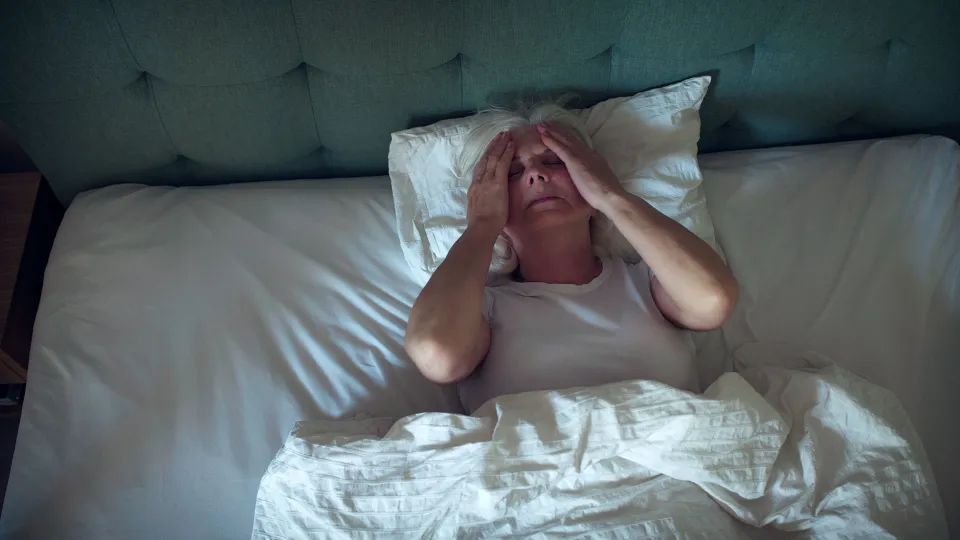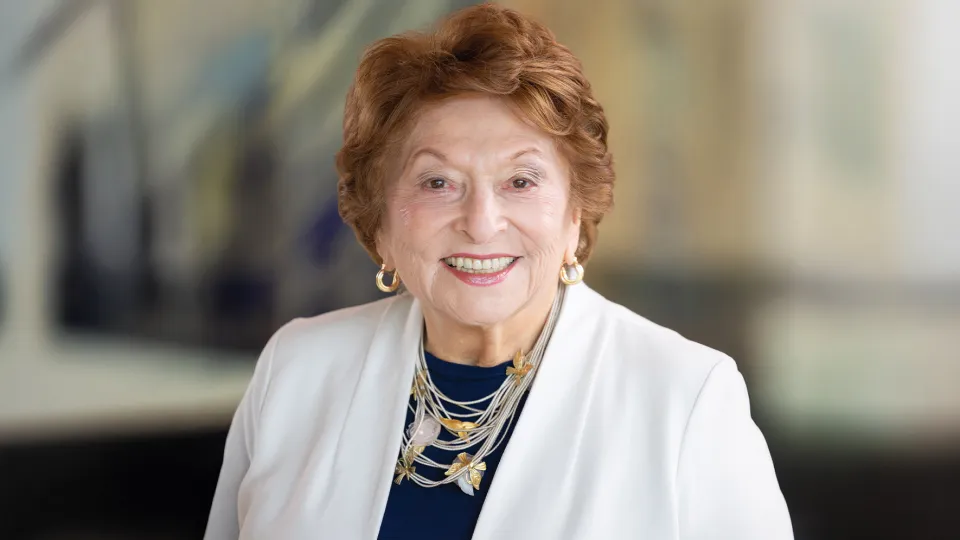Feature
2024 Presidential Lecture Features Work of COVID-19 Investigators
October 14, 2024

Einstein scientists Kartik Chandran, Ph.D., and Liise-anne Pirofski, M.D., were the honored speakers at Einstein’s fifth Presidential Lecture.
Einstein scientists Kartik Chandran, Ph.D., and Liise-anne Pirofski, M.D., discussed their research advances on SARS-CoV-2 and other emerging viruses during the fifth Presidential Lecture, held Wednesday, Sept. 25, in Robbins Auditorium. The annual lecture series was established to spotlight the outstanding research conducted at Albert Einstein College of Medicine and Montefiore Health System.
This year’s honored speakers worked on two urgent missions during the height of the COVID-19 pandemic: Dr. Pirofski described her studies of convalescent plasma, which was taken from people who had recovered from the infection and was then transfused into hospitalized patients; Dr. Chandran described his group’s work with emerging viruses—including SARS-CoV-2—aimed at preparing for and responding to new epidemics and pandemics.
Pamela Stanley, Ph.D., professor of cell biology and chair of the faculty interactions committee that selected this year’s featured speakers, introduced Philip O. Ozuah, M.D., Ph.D., president and CEO of Montefiore Einstein, and Yaron Tomer, M.D., the Marilyn and Stanley M. Katz Dean of Einstein and chief academic officer at Montefiore Einstein, who each delivered welcoming remarks.
Dr. Ozuah noted that science “is often a lonely profession, a single-minded researcher, one experiment at a time, charting new territory into the unknown. But as the work of these two brilliant collaborators shows, at Einstein, science is truly one of our most collegial and cooperative endeavors.”
In addition to being exceptional researchers, he said, Drs. Chandran and Pirofski “are extraordinary mentors, diligently guiding a new generation to seek, to find, to know, and to share with the world. … These award-winning presenters are among the most important public servants working in the field today. In their work they open the door to others in the exchange of ideas and innovation.”
Dr. Tomer noted that Einstein and Montefiore “together can do great things, and this was most evident during the pandemic. Montefiore was at the epicenter, caring for more patients than any other hospital.” The collaborations between physicians and researchers at the two institutions were highly successful, he said, leading to several key COVID-19 clinical trials that saved many lives. The presidential lecture, he said, “celebrates the cooperation of our two institutions, the physicians and scientists, and the world-renowned faculty on finding novel therapies for COVID.”
Kartik Chandran: Emerging Viruses
The first speaker was Dr. Chandran, who is professor of microbiology & immunology and is the Gertude and David Feinson Chair in Medicine and a Harold and Muriel Block Faculty Scholar in Virology at Einstein. He told the audience in Robbins and those watching via live stream that his lab focuses on a number of emerging viruses that have important public health implications. “You may wonder,” he said, “how does this one lab at Einstein study all these different agents?” He credited an “amazing cast of collaborators all over the world and an approach that we can deploy to study lots of different viruses very quickly with very minimal information about a new virus.”
He said that when COVID-19 first appeared, “we were working on a bunch of other things, like everybody else. But when the first sequences of the Wuhan strain of the virus were published, including the spike protein, we were immediately able to build a recombinant virus that encodes the spike protein of SARS-CoV-2.”
A “COVID Crew” of scientists in his lab as well as in collaborating labs at Einstein worked tirelessly for two years, he said, studying how the virus infects cells, supporting the evaluation and deployment of convalescent plasma to treat COVID-19 (see below), developing an antibody test for COVID-19, and sequencing the virus to learn about the strains circulating in the Bronx. They also built machine-learning-informed tools to better predict COVID-19 outcomes following hospitalization and helped develop a monoclonal antibody against the COVID-19 spike protein “that almost got to the clinic before Omicron happened.”
Dr. Chandran also discussed his work on understanding the infection mechanism of hantaviruses. These viruses infect mammals globally and are often fatal to people, and these studies will help develop tools to neutralize those viruses.
Working with a consortium of scientists he helped found in 2019 called Prometheus, a Center of Excellence in Translational Research funded by the National Institutes of Health (NIH), “we built a virus that actually glows fluorescently and has the hantavirus spike protein on it so we could use it as bait to go ‘fishing’ for antibodies,” he said. The group found an antibody that effectively protected hamsters against hantavirus disease at low doses, even when given up to seven days post-infection. “This antibody seems to work broadly for lots and lots of different viruses in this family,” Dr. Chandran said. “So we think that this is a candidate for a hantavirus therapeutic that could be deployed.” He added that he and his Prometheus partners are currently working to raise funding to move this antibody into the clinic.
Earlier in the month, Dr. Chandran received a major NIH grant, totaling $70 million over five years, to build a new consortium called PROVIDENT, which will help lead a national effort to prepare for future pandemics.
Liise-anne Pirofski: Convalescent Plasma Therapy
Dr. Chandran was followed by Dr. Pirofski, a physician-scientist and chief of the division of infectious diseases and the Selma and Dr. Jacques Mitrani Chair in Biomedical Research at Einstein and Montefiore. Her talk, “Through the Looking Glass: Lessons Relearned Amid a Pandemic,” focused on the emergency use of convalescent plasma, an old therapy that had the potential to save lives.
“I've worked on antibody immunity my whole career,” she explained, “but at the bench and with mice. When the COVID-19 pandemic struck, the urgent need to develop therapies motivated me to try my hand at clinical research.”
Thousands of desperately ill people sought care at Montefiore hospitals, and the division of infectious diseases saw more than 12,000 patients in the first six months of the pandemic, she said. She co-authored a viewpoint paper with her former Einstein colleague Arturo Casadevall, M.D., Ph.D., suggesting that COVID-19 convalescent plasma might be a stopgap measure until other therapies and vaccines were available. It was published in the Journal of Clinical Investigation on March 13, 2020.
“The rationale was really simple,” Dr. Pirofski continued. “Convalescent plasma had been used in prior pandemics. It was readily available from survivors, and it made sense biologically, since antibodies from recovered people have activity against what they recovered from, and therefore, when you give it to another person, it can provide a sort of ready-made immunity to a naive population.”
But unlike manufactured drugs, convalescent plasma needed to be produced from people. Dr. Pirofski described how hundreds of potential donors from Montefiore hospitals and clinics came forward to have their blood tested for antibodies on Dr. Chandran’s platforms. That led to the production of thousands of units of convalescent plasma by the New York Blood Center that were used in studies at Montefiore and nationwide.
Dr. Pirofski then described convalescent plasma studies conducted at Montefiore Einstein. A study published in JCI Insight in January 2021 led by Hyun Ah Yoon, M.D., associate professor of medicine at Einstein, did not show an overall benefit, but the study’s limitations led Drs. Pirofski and Yoon and Dr. Mila B. Ortigoza, M.D., Ph.D., of NYU Grossman School of Medicine to conduct a trial comparing COVID-19 convalescent plasma with a control (saline) that enrolled more than 900 patients from April 2020 to March 2021. The study was published in JAMA Internal Medicine on Dec. 13, 2021. Dr. Pirofski explained that although the trial did not meet its primary endpoint, convalescent plasma was likely to have benefited patients early in the pandemic before other treatments were available.
Today there is widespread immunity to the disease, but convalescent plasma remains a valuable therapy for immunosuppressed people with COVID-19 who cannot produce their own antibodies. “It's also cost-effective compared with other interventions, and this is important because small molecule drugs and monoclonals are expensive, and we know that they weren't available to everyone,” she said.
The work with convalescent plasma done at Einstein and Montefiore and across the globe “greatly enhanced our understanding of this old therapy, and we are in a much better place,” Dr. Pirofski concluded. “The lessons learned and relearned from convalescent plasma studies for COVID-19 can optimize its deployment in a future infectious disease emergency.”



